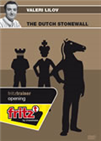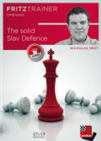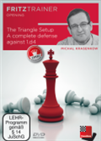Exploring Erwin l'Ami's Dutch Stonewall
A review
 The Dutch Stonewall is especially suitable for the average club player and the pawn skeleton which arises is the very reason for that. As a result, you do not need to study a lot of theory but just a few key plans and ideas that will successfully meet all possible replies by White! While this DVD covers most of the best lines for black, FM Valeri Lilov explores in more detail the Classical Stonewall with Be7, as well as the Modern Stonewall with Bd6.
The Dutch Stonewall is especially suitable for the average club player and the pawn skeleton which arises is the very reason for that. As a result, you do not need to study a lot of theory but just a few key plans and ideas that will successfully meet all possible replies by White! While this DVD covers most of the best lines for black, FM Valeri Lilov explores in more detail the Classical Stonewall with Be7, as well as the Modern Stonewall with Bd6.The Dutch is the first opening I learned against 1.d4, always thanks to a Chessbase DVD — The Dutch Stonewall, made few years ago by IM Valerie Lilov.
For those who don't know the Dutch Stonewall at all, l'Ami in the intro video shows the pawn structure which arises after the moves: 1.d4 f5 2.g3 Nf6 3.Bg2 e6 4.c4 d5 5.Nf3 c6 6.0-0 Bd6

In Lilov's DVD the main classical hero of the Stonewall, was Botvinnik, which we can see at work in the following games:
Unfortunately my experiences in tournament using the Dutch, against veteran players, didn't go so well. So I began my via crucis in order to find something else against 1.d4.
 This Slav DVD is a complete opening repertoire for black after 1.d4 d5 2.c4 c6. GM Nick Pert has played the Slav defence for over 10 years and provides all his latest and most up to date analysis crammed into one video series. Nick has spent many hours studying the best Slav lines, and he explains his favourite variations, plus includes some interactive clips where the viewer is tested on a range of theoretical questions and tactics arising from Slav games.
This Slav DVD is a complete opening repertoire for black after 1.d4 d5 2.c4 c6. GM Nick Pert has played the Slav defence for over 10 years and provides all his latest and most up to date analysis crammed into one video series. Nick has spent many hours studying the best Slav lines, and he explains his favourite variations, plus includes some interactive clips where the viewer is tested on a range of theoretical questions and tactics arising from Slav games. I studied the Slav by Pert, and the triangle setup by Krasenkow, again things didn't go well tournament wise.

I'm not blaming the authors of those DVDs — on the contrary, they did a great job — but from one side I had to mature as player, because I didn't study the opening correctly, and from another side, maybe there was too much material for what an amateur like me could really absorb — especially the Slav is really no joke!
Notice also another factor: Age, if I was younger, definitely the Slav is a must learn, but I'm old, and my memory is not so good. After I study all day long, I think some elves hit my brain reset button at night!
So why am I returning back to my first love? Lately I began to play 1.d4, and I realized that strangely the opening I had most problems against, as White, was the Dutch Stonewall. Now if a player 300 points below my rating, was able to draw in a game we played using the Stonewall, it made me think. But I archived the experience to bad luck. Then when this new DVD by GM l'Ami came out, I felt the need to learn the Stonewall again, and see if now it would give me better results. An interesting fact is that l'Ami also had my similar experience when playing as White against the Stonewall, and for this reason he made a thorough investigation of this opening, and while working on it, he found even more ways Black could make White's life difficult, and he shares some of his findings in the DVD. This is one of l'Ami's games against the Stonewall.
L'Ami in the introduction says that the Dutch Stonewall has been used by Carlsen to beat Caruana, and Anand. That made me quite curious, because before watching the games I thought Anand, maybe lost because he is my age (most people don't understand chess is a sport, and age definitely makes a difference!), but Caruana is definitely both on top and young, so age cannot be the factor for his loss.
Please pay attention to what could be considered a strange move played by Anand: 16.Nxd7; he gave up a good knight on the good outpost e5, for the bad bishop of the French and in this case the Dutch. I wish my opponents would be so caring and considerate when I play!
Jokes aside, we cannot think a former world champion, but also the lowest player, made a mistake or doesn't know what a bad bishop is. Instead, if we want to win more games, we need to ask ourselves what are the reasons behind that move. If I had to guess I'd say: the bishop is the defender of the light squares, if White traded such a strong knight for the bishop, then the next goal White might have is an exploitation of the light squares weakness. Since the result of the game was bad for White, I guess Anand wasn't able to carry out such plan successfully. But the next player could be, so we must always be prepared. Especially today when anyone — thanks to a silicon friend — could overcome the obstacles Anand found over the board.
By the way, in two other Chessbase DVDs, some great teachers — Sergei Tiviakov, and Sagar Shah — advise us to learn from 'the classics'. Such valuable and important advice is clearly valid in this case, and likely Anand — one of the greatest world champions, with a special memory — could have remembered unconsciously the idea of taking the Bd7 from the following game:
Now if taking the bishop on d7 is not the real mistake which made him lose the game, then we do need to analyze again, and understand why Anand lost? Perhaps, but this goes beyond the scope of this review. Still, it is a good hint one should follow if interested in playing for or against the Stonewall Dutch!
The other game mentioned was against Caruana, also this one is quite interesting:
Returning to the DVD review, l'Ami makes it abundantly clear that he will focus on teaching the development of the dark squared bishop on d6. Like he astutely mentions, in Botvinnik's time the bishop was developed to e7.

But why was I attracted to the Dutch in the first place? The idea is simple, and connected to what I wrote before, I'm an amateur, not a professional, my time for learning chess is limited, and I do accept the notion that in order to improve we should dedicate less time to learing openings, and more time to middlegame and endgames. So I try to learn openings where the "ideas" are more important than the correct move order or where is not essential to memorize the first 25 moves precisely like in the Sicilian Najdorf!
The DVD begins with six videos of typical maneuvers, and typical ideas. This is done to prove that the Dutch Stonewall is not an opening one needs to memorize sequence of moves, but just need to understand what to do, when, and why.
Then l'Ami also begins a theoretical section, however, there is a lack of coverage of some lines every Dutch defense player should know.
GM Williams, likely the biggest theoretical expert on the Dutch, with many books written on it at his credit, generally advises to play 1.d4 e6. Why? Because he is also a French defense expert, so if White doesn't want to enter the Dutch with 2.c4, he is quite happy to play the French. But what if White is quite well versed in some deviations like 1.d4 f5 2.Bg5
Or what about 2.Nc3? Or the Staunton gambit? 1.d4 f5 2.e4:
Notice also l'Ami lost a game against this line:
Of course one can also win in great style against the Staunton gambit. The idea I'm conveying is that one just needs to study it, and practice it a little to be sure if it happens in a tournament game there are no surprises!
What about other deviations which are really dangerous like: 1.d4 f5 2.h3:
Some players mistakenly think that pawn moves like h2-h3 are just waiting moves, but they are wrong. Look what happens in the following game, Black could resign by move 6, and he is a player rated around 2000.
Another dangerous line is: 1.d4 f5 2.g4:
L'Ami being a GM is very likely able to find the right way to refute these sidelines. Nevertheless, since I was a Dutch player in the beginning, I did study them to avoid surprises in tournament games, however, it was difficult to handle them in blitz and rapid games, hence the definite need to address them in a DVD, if the opening moves are 1.d4 f5.
While working on the DVD, and the model games I found other possible sidelines not treated, for example: 1.d4 e6 2.c4 f5 3.Nf3 Nf6 4.g3 d5 now instead of 5.Bg2, at club-amateur level a move like: 5.cxd5 can be quite common, how should Black deal with it?
Should Black take with the pawn or the knight? In the 50 model game, this line is not treated. But the question is important, because taking with the pawn would change the nature of the game — Black wouldn't have a backward weak pawn on e6 anymore. At the same time, out of 7 million games I have in my reference database, only 43 have been played with this line. And was it played mainly by low level amateurs, you ask? No, like in the following game where White is rated 2490!
This is all part of the homework one should diligently do. The GM teaching us the opening cannot really cover all the possibilities, furthermore that would create a vacuum in our brains! We do need to learn how to study an opening, and how to keep our openings updated. This is the reason why the Chessbase system is nearly unbeatable for emparting chess knowledge. As we can see from the above example I've found, thanks to Megabase 2017, 43 games on a line GM l'Ami didn't consider, and studied how I should play in such circumstance. Then of course I'll lose some games for whatever reasons, but from my side I've done all the best I could do, with the time I have for studying chess!
On the other hand, I must say I was impressed by the fact that l'Ami addressed the book of a great GM: Boris Avrukh, and gave a line to neutralize what GM Avrukh offered in the book as line against the Dutch Stonewall. Obviously I don't want to say more, because I know a lot of people read my reviews... and it wouldn't be fair toward l'Ami who researched the opening so thoroughly.
The reader of the review could ask me why do we need this DVD to learn the Dutch Stonewall, if l'Ami didn't really cover every possible line? My opinion is the following: we need l'Ami because he has GM level understanding. He is able to see the entire picture of the evolution of the opening, and how is played today, and convey that to us — like a modern art critic would be able to tell us everything behind a masterpiece held in one of the main museum in the world. This doesn't mean we should not consult other sources, or do our own homework. It just means that the great part of the work, 70-80% has been done for us through this DVD, and we do need to put effort for the remaining 20%, which are some of the sidelines I've pointed out above.
There is also another important point. Today we play many more games than in the past. The average GM has more than 2000 games in his career, while just 40-50 years ago the top GMs had maybe 700-1000 games throughout their careers. Now we can have that amount before even becoming titled players, and then twice as much in all possible different time controls. This means we clearly need to vary our opening repertoires, both for keeping our opponents in the dark, but most of all for growing as chess players.
This is the real reason we need to add this DVD to our chess libraries, because we want to grow as players. I found the beginning videos about the maneuvers and typical ideas extremely informative, and they gave me the gist of ideas I had to commit to memory. Then when I began to watch the latest games on ECO from A85 to A90, I was already able to spot White's and Black's ideas behind their moves, and how correct or wrong they were, thanks to l'Ami well structured videos!
Now, for a detailed review of what we find inside the DVD: the first 6 videos are typical ideas and maneuvers, they are a must watch, because l'Ami outlines clearly, like a great professor, the state of knowledge White and Black have upon this opening, and what works and what doesn't!
Then there are six videos on the following tabiya 1.d4 f5 2.g3 Nf6 3.Bg2 e6 4.c4 d5 5.Nf3 c6 6.0-0 Bd6:
L'Ami also did an exceptional job in choosing the games to teach us about this opening. The comments were great in focusing on the information we need to play the opening, like typical pawn breaks which happen in the above mentioned tabiya:

Notice how in Chessbase 14 a small diagram comes out at the right moment, to capture our attention, and make us focus on something which happens every time we have that pawn structure!
Follow the World Champion and your chess friend next door. Start your success story with ChessBase 14 and enjoy your chess even more! In addition to the Chessbase 14 Program the Starter Package contains:
• Access to the Live-Database (8 million games)*
• Big Database 2018
• CBMagazine subscription for half a year (3 issues)
• Database-Update-Service through end of 2018
• Six months Premium membership for playchess and for the ChessBase Accounts
There follows four videos on the following tabiya 1.d4 f5 2.g3 Nf6 3.Bg2 e6 4.c4 d5 5.Nf3 Bd6:
Three videos are dedicated to transposition lines with Nh3, as after: 1.d4 f5 2.g3 Nf6 3.Bg2 e6 4.Nh3:
L'Ami dedicates a video just to move order tricks, like those coming out of 1.d4 f5 2.Nf3 d5:
He clearly explains what the move order should be and why, and what he considers a mistake. This is the reason why we need a DVD with a GM explaining how to fine tune our move order, because he brings us to a level of understanding we wouldn't reach on our own.
The last three videos are dedicated to sidelines, and the last video is a theoretical overview. There are four videos which are dedicated to interactive training, where the teacher shows us a position or an entire game, and he asks questions to check if we understood the material, through finding the right move or plan. These last four videos are quite important in my opinion, one should watch them before a tournament, to see what he remembers, and what he misses of the material. The DVD comes with a database of 50 model games.
The running time of the DVD is approximately 5 hours and 25 minutes, clearly a lot of value for the small price we pay. My feelings for this DVD are quite positive, because I really felt the depth of the preparation l'Ami has. In every video he showed how deep was his grasp of where the pieces should be, and the reasons behind. I really felt he studied deeply the games he quotes as example, and found every microscopic flaw to eventually play against Black or exploit it against White. He must be a monster to play against on the board. And I wish he would make some DVDs with a collection of his games, because he is a great teacher to learn from.
Closing thoughts
 The polish GM Michal Krasenkow presents a repertoire based on the Noteboom and the Stonewall. Black's set-up may lead to a whole range of different and interesting positions, which help the black player to broaden his strategic and tactical understanding.
The polish GM Michal Krasenkow presents a repertoire based on the Noteboom and the Stonewall. Black's set-up may lead to a whole range of different and interesting positions, which help the black player to broaden his strategic and tactical understanding.
The Semi-Slav defense (1.d4 d5 followed by ...e7-e6 and ...c7-c6) is one of the most popular opening set-ups for Black. Black can follow two entirely different concepts. L'Ami on video 22, the one dedicated to 1.Nf3 clearly states that one cannot really enter the Stonewall if White knows what is doing. Such stubbornness in using the Stonewall at all costs could be quite detrimental, and he says one needs to have something else ready. Since I want to have a complete repertoire, and I guess everyone reading this wants it too, I'd like to suggest the DVD made by GM Krasenkow.
In that DVD Krasenkow treats the Stonewall, but he also gives a Semi-Slav repertoire which can work well against 1.Nf3, and cover all the possibilities for Black.
Again in the spirit of doing one's own homework, on video 21 L'Ami gives a move Bb4, which for him is similar to the Nimzo-Indian, while for me is more similar to the Classical Dutch. Hence, if one is serious about the Dutch, the masterwork "The Killer Dutch" written by GM Williams is a must read, because it will give a broader perspective on how to play in many different situations.
Please don't expect one DVD or one book — no matter how excellent and professional they are, or how great the teacher — will fully form your chess persona. One needs to be exposed to different authors, and ideas, in order to have a good understanding of the subject. But most of all a player must be an active learner, asking difficult questions, and be ready to pursue the often elusive answer.
Good luck in your Dutch games!























